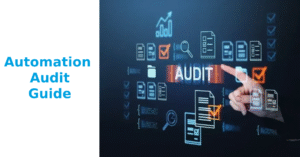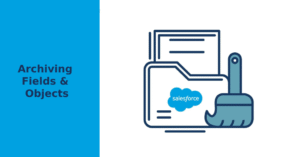
Salesforce is powerful — but left unchecked, your automations can turn into a tangled mess of Flows, Process Builders, and outdated rules that conflict or fail silently. 🧨
Whether you’re a Salesforce Admin, Consultant, or running RevOps, this guide will show you how to conduct a Salesforce automation audit that improves performance, reduces risk, and clears out technical debt — without breaking a thing.
Let’s dive into your 2025 audit checklist. 🛠️
🔍 What Is a Salesforce Automation Audit?
A Salesforce automation audit is a structured review of your org’s automations — including Flows, Process Builders, Workflow Rules, and Apex automations — to:
Before you jump into auditing, let’s clarify the goals. Here’s what a proper automation audit helps you accomplish:
- ✅ Identify redundant or conflicting logic
- ✅ Document and standardize automation usage
- ✅ Prepare for Salesforce’s automation roadmap (hint: Flows take over in 2025!)
- ✅ Improve system performance and scalability
📉 Poor automation hygiene leads to user errors, failed processes, and costly bugs.
🧼 Want a broader org checkup? See: How to Clean Up Your Salesforce Org
🧠 Why Every Admin Needs to Run an Automation Health Check
Still wondering if it’s worth the effort? Let’s break down the real-world benefits of a clean, streamlined automation strategy:
- 🚀 Faster processing speed
- 🧯 Less risk of process conflicts
- 🧠 Better understanding of business logic
- 🔎 Clear documentation for team handoffs
- 🧰 Readiness for Flow-first future
💡 Pro Tip: Reducing technical debt starts with taming your automations.
✅ Automation Audit Checklist
Before doing any deep-dive audits, take a few minutes to set the stage for success. These quick prep steps will make the whole process smoother and safer:
- 🔐 Set a sandbox or scratch org (never audit directly in production!)
- 📦 Export metadata using Salesforce Inspector, Workbench, or SFDX
- 📝 Create a simple spreadsheet to track:
- Automation type
- Trigger object
- Status (Active/Inactive)
- Last modified
- Description & business purpose
📚 You may also want to brush up on: Salesforce Flow Templates – 2025 Guide
🧭 Step-by-Step: How to Run a Salesforce Flow Audit
Here’s your roadmap — each step builds on the last to help you fully analyze, clean, and document your org’s automation logic.
🔄 Step 1: Inventory All Automations
Start by gathering everything. You can’t fix what you don’t know exists — and most orgs have way more automation running than they realize.
Run a full export of:
- ✅ Flows – via Setup > Flows or Metadata API
- ✅ Process Builders – using Setup Tree or Workbench
- ✅ Workflow Rules
- ✅ Apex Triggers & Classes tied to automation logic
🧠 Check: Guide to Apex Triggers in Salesforce
🧯 Step 2: Identify Conflicts and Overlaps
Now that you’ve collected your automation inventory, it’s time to pinpoint problem areas. Look for logic overlap, sequencing issues, and anything causing errors or redundancy.
Look for:
- 🚨 Multiple automations on the same object (especially
before updateandafter save) - 🔁 Infinite loops between Flows and email alerts
- 📛 Process Builders still active post-Flow migration
🛠️ Try: Getting Started with Salesforce Flows
🧹 Step 3: Deactivate or Retire Legacy Automations
After identifying what’s outdated or risky, take action. Carefully deactivate legacy logic and set clear markers for retirement or archiving.
- 🗑️ Deactivate redundant Process Builders (Salesforce is retiring these in 2025!)
- 🗃️ Archive automation metadata with prefixes like
zz_ordeprecated_ - ✅ Add comments in Flow descriptions for clarity
👀 Learn more about archiving metadata safely
📣 Communicate changes to your team or stakeholders.
🧪 Step 4: Test Every Active Automation Path
Testing is where the real audit magic happens. Your goal here is to catch any failures, inconsistencies, or unexpected behavior across all automation layers.
Use:
- 🧰 Debug Logs
- 🧪 Flow Debugger
- ✅ Unit Tests for Apex automation
- 💥 Fault path handling (See: Fault Paths in Flows Guide)
Check for:
- Data inconsistencies
- Failed record saves
- Missed alerts
🔁 Step 5: Document & Standardize Automation Usage
Good audits don’t just fix problems — they leave a trail others can follow. Use this step to build a long-term knowledge base for your org.
Create:
- 📄 Automation library spreadsheet or Notion doc
- 🔖 Tags/Labels:
Scheduled,Record-Triggered,Before Save,System User, etc. - 📘 One-page SOP for automation naming conventions
🧠 Bonus Resource: Salesforce Screen Flow Mastery – 2023 Guide
🔄 Step 6: Monitor Automation Health Going Forward
Auditing isn’t a “one-and-done” task. Here’s how to build continuous automation monitoring into your admin routine:
- 📊 Build dashboards for Flow fault tracking
- 🧼 Schedule monthly audits (15 min reviews)
- 📢 Align automations with RevOps best practices
🔧 Tools to Run a Salesforce Flow Audit Faster
Want to save hours? These free and paid tools will make your audit process 10x more efficient:
- ⚙️ Salesforce Optimizer – native audit suggestions
- 💼 Elements.Cloud – advanced metadata analysis
- 🧩 Salesforce Inspector – browser tool for metadata
🔗 See also: Best Chrome Extensions for Salesforce Admins
📈 What to Do After the Audit
Once the audit is complete, it’s time to act on your insights. These are the next moves that lock in long-term impact:
- 🌱 Plan Flow migrations from Process Builder
- 📚 Train teams on updated logic
- 🔁 Archive unused automation for future audits
- 🧮 Report on audit outcomes (e.g. load time, error reduction)
✅ Final Salesforce Flow Audit Checklist
- Inventory all automations
- Identify overlapping logic
- Deactivate/retire old automations
- Test active automations
- Document everything
- Set up monitoring dashboard
🚀 Wrapping Up
A Salesforce automation audit isn’t optional — it’s essential.
And in 2025, with the rise of Flow-first automation and the sunset of Process Builder, now’s the time to clean up, document, and scale your automations the smart way.
📚 Need a next step? Check out:
👉 How to Clean Up Your Salesforce Org
👉 Flow Templates & Best Practices Guide
🙋 Automation Health Check FAQs
❓How often should I run a Salesforce automation audit?
At a minimum, run an audit quarterly or before any major deployment or org change. If your org has frequent automation updates, monthly mini-audits are ideal.
❓What automations should I include in my audit?
Your audit should cover all Flows, Process Builders, Workflow Rules, Apex Triggers, and any third-party or AppExchange apps that trigger automations.
❓Is Process Builder really going away in 2025?
Yes — Salesforce is fully deprecating Process Builder and Workflow Rules in favor of Flow Builder. It’s best to migrate now using a phased audit and migration plan. Here’s how.
❓What’s the best way to identify overlapping automations?
Export all automation metadata and analyze triggers by object. Tools like Salesforce Inspector, Flow Explorer, and Salesforce Optimizer help flag overlaps and redundancies.
❓Can I test automations without using production data?
Yes — always run tests in a sandbox or developer org. Use tools like the Flow Debugger, Apex Test Classes, or build fault-handling paths in Flows to validate safely.
❓Do I need to audit Apex triggers too?
Absolutely. Apex is often used for behind-the-scenes automation logic. Include all trigger-based classes, especially those performing DML or calling other automation.
❓What’s the fastest way to document automations?
Start with a spreadsheet or Notion doc. Track:
- Type of automation
- Object and trigger event
- Business purpose
- Last modified
- Dependencies (like reports or alerts)
Use naming conventions and clear descriptions to keep everything searchable and handoff-friendly.
❓What tools do you recommend for auditing automations?
Try:
📊 Elements.Cloud (visual maps and metadata health)
🔍 Salesforce Optimizer (native insights)
⚙️ Salesforce Inspector (metadata extraction)



